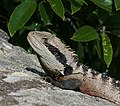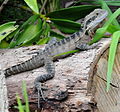Australian water dragon
| Australian water dragon | |
|---|---|
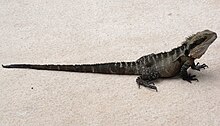
| |
| Intellagama lesueurii lesueurii | |
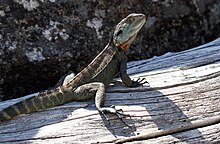
| |
| Intellagama lesueurii howittii | |
| Scientific classification | |
| Domain: | Eukaryota |
| Kingdom: | Animalia |
| Phylum: | Chordata |
| Class: | Reptilia |
| Order: | Squamata |
| Suborder: | Iguania |
| Family: | Agamidae |
| Genus: | Intellagama Wells & Wellington, 1985 |
| Species: | I. lesueurii
|
| Binomial name | |
| Intellagama lesueurii (Gray, 1831)
| |
| Subspecies | |
| |
| Synonyms[2][3] | |
| |
The Australian water dragon (Intellagama lesueurii),[2] which includes the eastern water dragon (Intellagama lesueurii lesueurii) and the Gippsland water dragon (Intellagama lesueurii howittii) subspecies, is a semi aquatic agamid species native to eastern Australia from Victoria northwards to Queensland. There may be a small introduced population on the south-east coast of South Australia. The Gippsland water dragon is generally the more southern of the two subspecies and the more cold adapted and heat sensitive. Visually distinguishing the Gippsland water dragon from the Eastern water dragon is relatively easy, as long as their skin is reasonably clean and not stained from the water, as identification of the two subspecies depends largely on observable differences in colours and patterns.
The Gippsland water dragon may be distinguished by its green-blue colour, especially during the breeding season, when this overall colouration is quite distinct. Another key difference is the absence of a prominent dark stripe behind the eye in the Gippsland water dragon, which is characteristic of the Eastern water dragon. The gular region of the two subspecies is also quite different, with Intellagama l. howittii having orange-yellow streaked with darker striping, which is sometimes quite striking, particularly in mature males, whereas Intellagama l. lesueurii typically has a pale, unmarked throat that is sometimes immaculate white in mature males. The belly and chest of Intellagama l. howittii are also quite different to Intellagama l. lesueurii, usually being blackish green, especially in mature males, and the limbs are often quite dark, sometimes even black. Whereas in Intellagama l. lesueurii the chest and belly are usually bright to deep red, particularly in mature males. Intellagama l. lesueurii also have relatively strong dark transverse bars across the back, whereas these dark bars are often much reduced in the Gippsland water dragon.
Etymology
[edit]The specific name, lesueurii, is in honor of French naturalist Charles Alexandre Lesueur.[4]
Taxonomy and systematics
[edit]The species was first described by John Edward Gray in 1831 as Lophura lesueurii, from a specimen collected by Lesueur & Péron at "Parramatta" or "Port Jackson".[5][6] Gray listed three species of Lophura: Cuvier's (Lophura Cuvierii Gray), Lesueur's (Lophura Lesueurii Gray), and beautiful (Lophura Concinna Gray, Physignathus Concinnus[a] Cuvier).[5]
In 1845,[7] Gray separated Physignathus (P. concinnus & P. Lesueurii) from Lophura (L. amboinensis[b] & L. Shawii[c]). The Australian water dragon remained in Physignathus along with the Asian water dragon P. cocincinus until Wells and Wellington published the genus Intellagama in 1985.
The subspecies howitii was described by Frederick McCoy in 1884 as "the Gippsland water lizard". According to his description, it differs from the Queensland subspecies in the proportions of the head and the supra-ocular scales. Its sub-specific epithet commemorates geologist and magistrate Alfred William Howitt, who collected three specimens from the upper reaches of the Buchan River and sent them to McCoy.[8] Two of the specimens cannot be located,[9] the third is D1822[10] in the collection of the National Museum of Victoria, which was designated the lectotype by Coventry in 1970.[9]
Description
[edit]Australian water dragons have long powerful limbs and claws for climbing, a long muscular laterally-compressed tail for swimming, and prominent nuchal and vertebral crests.[11] (A nuchal crest is a central row of spikes at the base of the head. These spikes continue down the spine, getting smaller as they reach the base of the tail.)[12]
Including their tails, which comprise about two-thirds of their total length, adult females grow to about 60 cm (2 feet) long, and adult males can grow slightly longer than one metre (39 inches) and weigh about 1 kg. Males show bolder colouration and have larger heads than females.[13][14] Colour is less distinct in juveniles.[15]
Species variation
[edit]The Australian water dragon is the only species of the genus Intellagama.[2]
There are two subspecies; Intellagama lesueurii lesueurii (eastern water dragon) and Intellagama lesueurii howittii (Gippsland water dragon). The nominate subspecies Intellagama lesueurii lesueurii has a dark band behind its eye and an essentially un-patterned throat that tends towards white and is often immaculate in adult males. Whereas the subspecies Intellagama lesueurii howittii lacks the dark stripe behind the eye and has a patterned throat, which is lightly patterned in females but boldly patterned and coloured in adult males. This patterning usually consists of a dark stripe on either side of its throat, and blotched with orange, yellow or blue towards the centre of the throat. Both subspecies are light greenish grey in overall colour (greener in I. l. howittii), with darker bands running across their back, tail and legs. The water dragon can slowly change skin colour to aid its camouflage. The skin will shed during periods of growth and seasonally to reveal brighter colours in Spring that may aid breeding success.
Behaviour
[edit]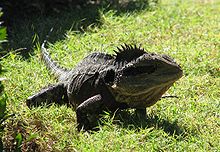
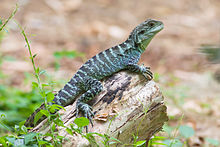
Australian water dragons are extremely shy in the wild, but readily adapt to continual human presence in suburban parks and gardens. They are fast runners and strong climbers. When faced with a potential predator, they seek cover in thick vegetation, or drop from an overhanging branch into water. They are able to swim totally submerged, and rest on the bottom of shallow creeks or lakes for up to 90 minutes,[12] to avoid detection.
Both males and females display typical agamid behaviour such as basking, arm-waving and head-bobbing. Fast arm-waving signals dominance, while slow arm-waving signals submission. Males are territorial,[11] and in areas of higher population density, males exhibit displays of aggression toward other males including posturing, chasing and fighting.
Breeding
[edit]Australian water dragons living in cooler Australian climates hibernate over winter. During spring, usually in early October, the female excavates a burrow about 10–15 cm (3.9–5.9 in) deep and lays between 6 and 18 eggs.[11] The nest is usually in sandy or soft soil, in an area open to sun. When the mother has laid the eggs, she backfills the chamber with soil and scatters loose debris over it. Australian water dragons exhibit temperature dependent sex determination; the sex of the hatchlings is determined by the temperature of the nest site.[12]
When the young are hatched, they stay near the entrance of the burrow for some time before leaving home. When they finally leave the nest, they tend to group together away from the adult population.[13]
Habitat
[edit]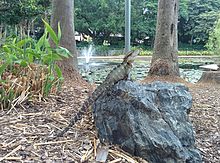
As its common name suggests, the Australian water dragon is associated with water and is semi-aquatic. It can be found near creeks, rivers, lakes, and other water bodies that have basking sites such as overhanging branches or rocks in open or filtered sun. The species is very common in the rainforest section of Brisbane Botanic Gardens, Mount Coot-tha in Queensland, and a monument has been built to them there. There is also a significant population in Brisbane's Roma Street Parklands.
There are anecdotal reports of a small colony living on the Sixth Creek in the Forest Range area of South Australia, hundreds of kilometers outside their natural range, which were probably introduced there during the 1980s by a local reptile enthusiast.[citation needed]
Predators, threats and diet
[edit]Australian water dragons are prey to carnivorous birds, snakes, cats, dogs, and foxes. Nestlings and smaller juvenile water dragons are vulnerable to predation by kookaburras, currawongs, butcherbirds and other carnivorous birds.[16] They are also prone to becoming road kill due to the attraction of warm bitumen and concrete for basking.[16] The Australian water dragon's diet depends on its size. Juveniles and yearlings tend to feed on spiders and small insects such as ants, crickets, and caterpillars. When they get bigger, so does their prey. An adult diet includes small rodents, such as baby mice, other reptiles, frogs, fish, crabs, yabbies, molluscs, worms and eggs, although insects are still the most commonly consumed.[17][18][19][20][21][22] Types of vegetation reportedly consumed include figs, lilly-pilly fruits, berries, and other fruits and flowers.[17][18][20]
Gallery
[edit]-
Eastern water dragon (Intellagama lesueurii lesueurii) at Lane Cove National Park
-
Australian water dragon, Brisbane
-
Intellagama lesueurii lesueurii (eastern water dragon) at Kirra, Queensland
-
Intellagama lesueurii lesueurii (eastern water dragon)
-
Swimming across river in Melbourne
-
Head detail of the eastern subspecies
-
Intellagama lesueurii lesueurii (eastern water dragon) basking on a log in suburban Sydney
-
Intellagama lesueurii lesueurii swimming, Shoalhaven River, New South Wales
-
Australian water dragon surveying Sydney Harbour
-
Eastern water dragon at Brisbane Botanic Gardens
-
Eastern water dragon at Brisbane Botanic Gardens
-
Juvenile eastern water dragon in Roma Street Parkland, Brisbane, Queensland, Australia
-
Eastern water dragon in Brisbane Botanical Gardens
-
Head of an eastern water dragon poking out of a pond in Brisbane Botanical Gardens
-
Two male Australian eastern water dragons (Intellagama lesueurii lesueurii ) fighting.
-
Australian eastern water dragon basking in the sun at Blue Mountains (New South Wales)
-
A water dragon that has been marked for research purposes.
-
Adult male Australian Eastern water dragon in a tree overhanging a creek in suburban Brisbane
-
Northern form, showing yellow spots on flank (photographed near Cooktown).
Notes
[edit]- ^ Cuvier's original spelling was Physignathus cocincinus, after the type locality "cocincine" (Cochin-China).
- ^ The name Lophura was already used for a genus of pheasants, the current name is Hydrosaurus amboinensis.
- ^ Shawii now considered to be conspecific with amboinensis.
References
[edit]- ^ Tallowin, O.; Hobson, R.; Venz, M.; Wilson, S.; Shea, G.; Vanderduys, E. (2018). "Intellagama lesueurii ". IUCN Red List of Threatened Species. 2018: e.T22566194A22566245. doi:10.2305/IUCN.UK.2018-1.RLTS.T22566194A22566245.en. Retrieved 19 November 2021.
- ^ a b c Amey, A.P.; Couper, P.J.; Shea, G.M. (2012). "Intellagama lesueurii (Gray, 1831), the correct binomial combination for the Australian Eastern Water Dragon (Sauria, Agamidae)" (PDF). Zootaxa. 3390 (1): 65–67. doi:10.11646/zootaxa.3390.1.6.
- ^ Species Intellagama lesueurii at The Reptile Database www.reptile-database.org.
- ^ Beolens B, Watkins M, Grayson M (2011). The Eponym Dictionary of Reptiles. Baltimore: Johns Hopkins University Press. xiii + 296 pp. ISBN 978-1-4214-0135-5. (Physignathus lesueurii, p. 156).
- ^ a b Gray, John Edward (1831). "A Synopsis of the Species of Class Reptilia". In Griffith, Edward (ed.). A Classified Index and Synopsis of the Animal Kingdom arranged in Conformity with its Organisation by the Baron Cuvier. Volume IX, Reptilia. London: Whittaker & Co. p. s. 60.
- ^ "Spécimen MNHN-RA-0.392: Intellagama lesueurii (Gray, 1831)". science.mnhn.fr. Muséum National de Histoire Naturelle. Retrieved 24 February 2023.
- ^ Gray, John Edward (1845). Catalogue of the Specimens of Lizards in the Collection of the British Museum. London: Trustees of the British Museum. (Edward Newman, printer). pp. 247–248.
- ^ McCoy, Frederick (1884). "Physignathus leusueurii (Gray), Var. howitii (McCoy)". Natural History of Victoria. Prodromus of the Zoology of Victoria, or, Figures and Descriptions of the Living Species of All Classes of the Victorian Indigenous Animals. Decade IX. Melbourne: Government Printer: 7–10, plate 81.
- ^ a b Coventry, A.J. (1970). "Reptile and amphibian type specimens housed in the National Museum of Victoria". Memoirs of the National Museum of Victoria. 31: 115–124. doi:10.24199/j.mmv.1970.31.13. P. l. howitii is on page 117
- ^ "Specimen D 1822: Physignathus lesueurii howittii McCoy, 1884". Museums Victoria Collections. Retrieved 24 February 2023.
- ^ a b c Maruyama, Kaori; Langkilde, Tracy, Physignathus lesueurii (PDF), James Cook University, archived from the original (PDF) on 2008-07-27, retrieved 2009-05-21
- ^ a b c Australian National Botanic Gardens: Research into Water Dragons Archived June 30, 2007, at the Wayback Machine
- ^ a b "Critters of Calamvale Creek: Eastern Water Dragon". Calamvalecreek.awardspace.com. Archived from the original on 2011-07-25. Retrieved 2013-07-09.
- ^ "Australian Museum Online: Wildlife of Sydney". Archived from the original on 2007-06-12. Retrieved 2007-07-02.
- ^ "Critters of Calamvale Creek: baby Eastern Water Dragon". Calamvalecreek.awardspace.com. Archived from the original on 2011-07-25. Retrieved 2013-07-09.
- ^ a b Australian National Botanic Gardens: Predators of Water Dragons Archived November 21, 2008, at the Wayback Machine
- ^ a b "Australian Water Dragon".
- ^ a b "Eastern Water Dragon".
- ^ "Eastern Water Dragon". 23 September 2020.
- ^ a b "Eastern Water Dragon - the Animal Facts - Appearance, Diet, Habitat".
- ^ "Australian Water Dragon Care Sheet".
- ^ "Water Dragon". 20 April 2020.
Further reading
[edit]- Boulenger GA (1885). Catalogue of the Lizards in the British Museum (Natural History). Second Edition. Volume I. ... Agamidæ .... London: Trustees of the British Museum (Natural History). (Taylor and Francis, printers). xii + 436 pp. + Plates I–XXXII. (Physignathus lesueurii, pp. 398–399).
- Cogger HG (2014). Reptiles and Amphibians of Australia, Seventh Edition. Clayton, Victoria, Australia: CSIRO Publishing. xxx + 1,033 pp. ISBN 978-0643100350.
- Wilson S, Swan G (2023). A Complete Guide to Reptiles of Australia, Sixth Edition. Sydney: Reed New Holland Publishers. 688 pp. ISBN 978-1-92554-671-2. (Intellagama lesueurii, pp. 478–479).
External links
[edit]- Video of male Gippsland water dragons fighting on Youtube
- Australian National Botanic Gardens Research
- Maruyama, K.; Langkilde, T. (1999). "Physignathus lesueurii " (PDF). Archived from the original (PDF) on 2008-07-27.
- "Physignathus lesueurii ". James Cook University - Discover Nature. Archived from the original on 2010-01-03. Retrieved 2009-04-19.
- Reptiles of Lamington National Park. "Physignathus lesueurii ". Archived from the original on 2004-03-22.
- "Physignathus lesueurii howittii ". ozanimals.com.
- Physignathus lesueurii at the Reptarium.cz Reptile Database







